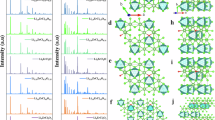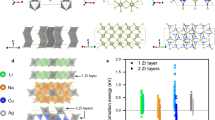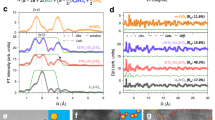Abstract
Halides of the family Li3MX6 (M = Y, In, Sc and so on, X = halogen) are emerging solid electrolyte materials for all-solid-state Li-ion batteries. They show greater chemical stability and wider electrochemical stability windows than existing sulfide solid electrolytes, but have lower room-temperature ionic conductivities. Here we report the discovery that the superionic transition in Li3YCl6 is triggered by the collective motion of anions, as evidenced by synchrotron X-ray and neutron scattering characterizations and ab initio molecular dynamics simulations. Based on this finding, we used a rational design strategy to lower the transition temperature and thus improve the room-temperature ionic conductivity of this family of compounds. We accordingly synthesized Li3YClxBr6−x and Li3GdCl3Br3 and achieved very high room-temperature conductivities of 6.1 and 11 mS cm−1 for Li3YCl4.5Br1.5 and Li3GdCl3Br3, respectively. These findings open new routes to the design of room-temperature superionic conductors for high-performance solid batteries.

This is a preview of subscription content, access via your institution
Access options
Access Nature and 54 other Nature Portfolio journals
Get Nature+, our best-value online-access subscription
$32.99 / 30 days
cancel any time
Subscribe to this journal
Receive 12 print issues and online access
$259.00 per year
only $21.58 per issue
Buy this article
- Purchase on SpringerLink
- Instant access to full article PDF
Prices may be subject to local taxes which are calculated during checkout






Similar content being viewed by others
Data availability
All of the data that support the findings of this work are available within the paper and its Supplementary Information. Source data are provided with this paper.
References
Janek, J. & Zeier, W. G. A solid future for battery development. Nat. Energy 1, 16141 (2016).
Kato, Y. et al. High-power all-solid-state batteries using sulfide superionic conductors. Nat. Energy 1, 16030 (2016).
Murugan, R., Thangadurai, V. & Weppner, W. Fast lithium ion conduction in garnet-type Li7La3Zr2O12. Angew. Chem. Int. Ed. 46, 7778–7781 (2007).
Zhao, N. et al. Solid garnet batteries. Joule 3, 1190–1199 (2019).
Zhang, B., Lin, Z., Dong, H., Wang, L.-W. & Pan, F. Revealing cooperative Li-ion migration in Li1+xAlxTi2−x(PO4)3 solid state electrolytes with high Al doping. J. Mater. Chem. A 8, 342–348 (2020).
Liu, Z., Qin, X., Xu, H. & Chen, G. One-pot synthesis of carbon-coated nanosized LiTi2(PO4)3 as anode materials for aqueous lithium ion batteries. J. Power Sources 293, 562–569 (2015).
Kraft, M. A. et al. Influence of lattice polarizability on the ionic conductivity in the lithium superionic argyrodites Li6PS5X (X = Cl, Br, I). J. Am. Chem. Soc. 139, 10909–10918 (2017).
Yamane, H. et al. Crystal structure of a superionic conductor, Li7P3S11. Solid State Ion. 178, 1163–1167 (2007).
Seino, Y., Ota, T., Takada, K., Hayashi, A. & Tatsumisago, M. A sulphide lithium super ion conductor is superior to liquid ion conductors for use in rechargeable batteries. Energy Environ. Sci. 7, 627–631 (2014).
Kamaya, N. et al. A lithium superionic conductor. Nat. Mater. 10, 682–686 (2011).
Park, K. H. et al. Design strategies, practical considerations, and new solution processes of sulfide solid electrolytes for all-solid-state batteries. Adv. Energy Mater. 8, 1800035 (2018).
Asano, T. et al. Solid halide electrolytes with high lithium-ion conductivity for application in 4 V class bulk-type all-solid-state batteries. Adv. Mater. 30, 1803075 (2018).
Li, X. et al. Water-mediated synthesis of a superionic halide solid electrolyte. Angew. Chem. Int. Ed. 58, 16427–16432 (2019).
Liang, J. et al. Site-occupation-tuned superionic LixScCl3+xhalide solid electrolytes for all-solid-state batteries. J. Am. Chem. Soc. 142, 7012–7022 (2020).
Wang, K. et al. A cost-effective and humidity-tolerant chloride solid electrolyte for lithium batteries. Nat. Commun. 12, 4410 (2021).
Kwak, H. et al. Boosting the interfacial superionic conduction of halide solid electrolytes for all-solid-state batteries. Nat. Commun. 14, 2459 (2023).
Kwak, H. et al. Li+ conduction in aliovalent-substituted monoclinic Li2ZrCl6 for all-solid-state batteries: Li2+xZr1−xMxCl6 (M = In, Sc). Chem. Eng. J. 437, 135413 (2022).
Li, F. et al. Stable all-solid-state lithium metal batteries enabled by machine learning simulation designed halide electrolytes. Nano Lett. 22, 2461–2469 (2022).
Helm, B. et al. Exploring aliovalent substitutions in the lithium halide superionic conductor Li3−xIn1−xZrxCl6 (0 ≤ x ≤ 0.5). Chem. Mater. 33, 4773–4782 (2021).
Wang, S. et al. Lithium chlorides and bromides as promising solid-state chemistries for fast ion conductors with good electrochemical stability. Angew. Chem. Int. Ed. 58, 8039–8043 (2019).
Liu, Z. et al. High ionic conductivity achieved in Li3Y(Br3Cl3) mixed halide solid electrolyte via promoted diffusion pathways and enhanced grain boundary. ACS Energy Lett. 6, 298–304 (2021).
Steiner, H. J. & Lutz, H. D. Neue schnelle Ionenleiter vom Typ MI3MIIICl6 (MI = Li, Na, Ag; MIII = In, Y). Z. Anorg. Allg. Chem. 613, 26–30 (1992).
Ito, H. et al. Kinetically stabilized cation arrangement in Li3YCl6 superionic conductor during solid-state reaction. Adv. Sci. 8, 2101413 (2021).
Yu, S. et al. Design of a trigonal halide superionic conductor by regulating cation order-disorder. Science 382, 573–579 (2023).
Schlem, R. et al. Mechanochemical synthesis: a tool to tune cation site disorder and ionic transport properties of Li3MCl6 (M = Y, Er) superionic conductors. Adv. Energy Materials 10, 1903719 (2020).
Qi, J. et al. Bridging the gap between simulated and experimental ionic conductivities in lithium superionic conductors. Mater. Today Phys. 21, 100463 (2021).
Wang, S., Liu, Y. & Mo, Y. Frustration in super-ionic conductors unraveled by the density of atomistic states. Angew. Chem. Int. Ed. 62, e202215544 (2023).
Sebti, E. et al. Stacking faults assist lithium-ion conduction in a halide-based superionic conductor. J. Am. Chem. Soc. 144, 5795–5811 (2022).
Bohnsack, A. et al. Ternäre Halogenide vom Typ A3MX6. VI [1]. Ternäre Chloride der Selten-Erd-Elemente mit Lithium, Li3MCl6 (M = Tb−Lu, Y, Sc): Synthese, Kristallstrukturen und Ionenbewegung. Z. Anorg. Allg. Chem. 623, 1067–1073 (1997).
Gupta, M. K. et al. Fast Na diffusion and anharmonic phonon dynamics in superionic Na3PS4. Energy Environ. Sci. 14, 6554–6563 (2021).
Muy, S., Schlem, R., Shao-Horn, Y. & Zeier, W. G. Phonon–ion interactions: designing ion mobility based on lattice dynamics. Adv. Energy Mater. 11, 2002787 (2021).
Shannon, R. Revised effective ionic radii and systematic studies of interatomic distances in halides and chalcogenides. Acta Crystallogr. A 32, 751–767 (1976).
Neuefeind, J., Feygenson, M., Carruth, J., Hoffmann, R. & Chipley, K. K. The nanoscale ordered materials diffractometer NOMAD at the spallation neutron source SNS. Nucl. Instrum. Methods Phys. Res. B 287, 68–75 (2012).
Coelho, A. TOPAS and TOPAS-Academic: an optimization program integrating computer algebra and crystallographic objects written in C++. J. Appl. Crystallogr. 51, 210–218 (2018).
Ikeda, S. & Carpenter, J. M. Wide-energy-range, high-resolution measurements of neutron pulse shapes of polyethylene moderators. Nucl. Instrum. Methods Phys. Res. A 239, 536–544 (1985).
Larson, A. C. & Von Dreele, R. B. GSAS, Report lAUR 86–748 (Los Alamos National Laboratory, 1994).
Zhang, Y., Liu, J. & Tucker, M. G. Lorentz factor for time-of-flight neutron Bragg and total scattering. Acta Crystallogr. A 79, 20–24 (2023).
Liu, J. et al. Anionic redox induced anomalous structural transition in Ni-rich cathodes. Energy Environ. Sci. 14, 6441–6454 (2021).
Kresse, G. & Furthmüller, J. Efficient iterative schemes for ab initio total-energy calculations using a plane-wave basis set. Phys. Rev. B 54, 11169–11186 (1996).
Blöchl, P. E. Projector augmented-wave method. Phys. Rev. B 50, 17953–17979 (1994).
Perdew, J. P., Burke, K. & Ernzerhof, M. Generalized gradient approximation made simple. Phys. Rev. Lett. 77, 3865–3868 (1996).
Jain, A. et al. Commentary: the Materials Project: a materials genome approach to accelerating materials innovation. APL Mater. 1, 011002 (2013).
Nosé, S. A unified formulation of the constant temperature molecular dynamics methods. J. Chem. Phys. 81, 511–519 (1984).
He, X., Zhu, Y. & Epstein, A. et al. Statistical variances of diffusional properties from ab initio molecular dynamics simulations. npj Comput. Mater. 4, 18 (2018).
Acknowledgements
Z.L. and H.C. acknowledge the financial support from the US National Science Foundation (grant nos. 1706723 and 2108688) and the faculty start-up fund of Georgia Tech. The facilities at the Advanced Photon Source at Argonne National Laboratory were made available through the General User Program, supported by the US Department of Energy (DOE), Office of Science, Office of Basic Energy Sciences (contract no. DE-AC02-06CH11357). Also used in this study was the 28ID-2 XPD beamline of the National Synchrotron Light Source II, a US DOE Office of Science User Facility operated for the DOE Office of Science by Brookhaven National Laboratory (contract no. DE-SC0012704). A portion of this research was carried out at the Spallation Neutron Source, a DOE Office of Science User Facility operated by the Oak Ridge National Laboratory. We thank J. Bai and W. Xu for help with the synchrotron experiments. Z.L. and H.C. thank M. McDowell for help with the low-temperature EIS measurements. M.L. and S.X. acknowledge the support of the National Science Foundation (grant no. NSF-CMMI-1554393). Y.M. acknowledges funding from the US National Science Foundation (award no. 2004837) and access to the computational facilities at the University of Maryland.
Author information
Authors and Affiliations
Contributions
Z.L. and H.C. conceived the idea and designed the experiments. Z.L. conducted the synthesis, electrochemical tests and some of the characterizations. P.-H.C. and J.L. performed the ND characterizations and analyses. S.W. performed the computer simulations under the supervision of Y.M. S.S. and S.C. contributed to the processing of the materials. M.L., Z.L. and S.X. performed mechanical property measurements and analyses. Z.L., H.C., J.L. and S.W. wrote the paper. All authors reviewed and revised the paper.
Corresponding authors
Ethics declarations
Competing interests
The authors declare no competing interests.
Peer review
Peer review information
Nature Chemistry thanks the anonymous reviewers for their contribution to the peer review of this work.
Additional information
Publisher’s note Springer Nature remains neutral with regard to jurisdictional claims in published maps and institutional affiliations.
Supplementary information
Supplementary Information
Supplementary Figs. 1–25 and Tables 1–16.
Supplementary Video 1
Rocking motion from 100 to 400 K.
Supplementary Video 2
Rocking–breathing motion transition from 400 to 500 K.
Supplementary Video 3
BN1 change under rocking motion from 100 to 400 K.
Supplementary Video 4
BN1 change from rocking motion at 400 K to breathing motion at 500 K.
Supplementary Video 5
BN3 change under rocking motion from 100 to 400 K.
Supplementary Video 6
BN3 change from rocking motion at 400 K to breathing motion at 500 K.
Source data
Source Data Fig. 1
Statistical source data.
Source Data Fig. 2
Statistical source data.
Source Data Fig. 3
Statistical source data.
Source Data Fig. 4
Statistical source data.
Source Data Fig. 5
Statistical source data.
Source Data Fig. 6
Statistical source data.
Rights and permissions
Springer Nature or its licensor (e.g. a society or other partner) holds exclusive rights to this article under a publishing agreement with the author(s) or other rightsholder(s); author self-archiving of the accepted manuscript version of this article is solely governed by the terms of such publishing agreement and applicable law.
About this article
Cite this article
Liu, Z., Chien, PH., Wang, S. et al. Tuning collective anion motion enables superionic conductivity in solid-state halide electrolytes. Nat. Chem. 16, 1584–1591 (2024). https://doi.org/10.1038/s41557-024-01634-6
Received:
Accepted:
Published:
Issue date:
DOI: https://doi.org/10.1038/s41557-024-01634-6
This article is cited by
-
Ionic potential for battery materials
Nature Reviews Materials (2025)
-
Study on the Removal Mechanism and Kinetics of Impurity P in the Blowing Refining Process of Industrial Silicon
Metallurgical and Materials Transactions B (2025)
-
Accelerated discovery of solid-state battery properties enabled by active learning approaches
Science China Materials (2025)
-
Regulated anion configuration enables ultrafast Li-ion transport
Nature Chemistry (2024)



